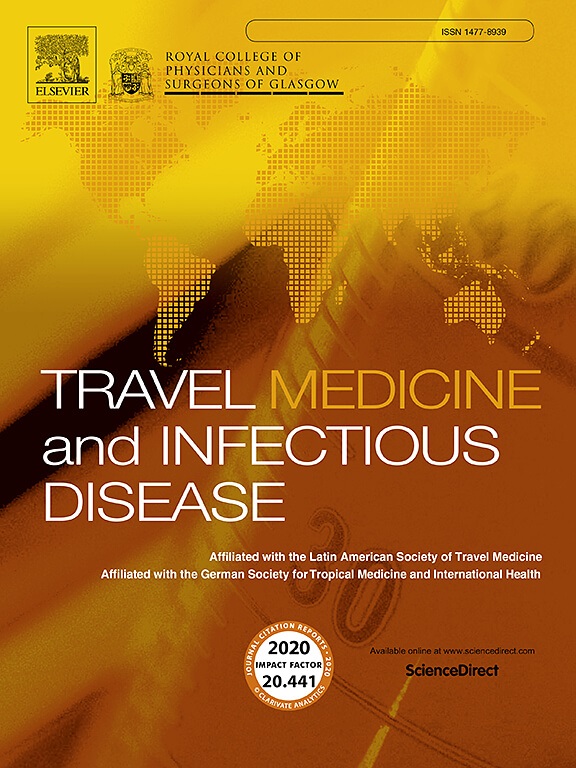Extended Lake Louise Score: a novel standard evaluation of cognitive impairment for immigrants' rapid ascent to high altitude
IF 4.7
3区 医学
Q1 INFECTIOUS DISEASES
引用次数: 0
Abstract
Objective
To extend the Lake Louise Scoring (LLS) system to better assess cognitive impairment, and investigate the early changes of hematological indicators for subjects of rapid ascent to high altitude.
Methods
One hundred and eighty-nine subjects underwent routine hematology, urine and psychological examination at the altitude of 1500 m in February, and did that again after they had ascended to 3860 m in 2 days. Subjects were evaluated with eLLS using a combination of self-reported cognitive assessment and a diagnosis of AMS based on 4-item Lake Louise Score (LLS) of Acute Mountain Sickness (AMS). Next year, a follow-up validation was conducted in the same area.
Results
Sixty-eight subjects were diagnosed AMS with LLS and 92 subjects met the diagnostic criteria of eLLS among 189 subjects. The difference in hematological indicators calculated by the eLLS criteria was more significant than that calculated by the LLS criteria, which including red blood cells (P < 0.01), white blood cells (P < 0.05), hemoglobin (P < 0.01), platelets (P < 0.01) and neutrophils (P < 0.01). The eLLS identified additional risk factors comparing with LLS, which included higher white blood cells (OR 1.660, 95 % CI 1.032–2.670, P < 0.05), neutrophils (OR 1.312, 95 % CI 1.002–1.718, P < 0.05). Follow-up results showed that there were more significant differences in psychological scale scores between the groups identified using the eLLS criteria. (P < 0.05).
Conclusion
We proposed eLLS standard for individuals rapidly ascending to high altitude, which is more sensitive to hematological changes and can better reflect the cognitive mental state than the LLS.
扩展路易斯湖得分:移民快速上升到高海拔认知障碍的新标准评估。
目的:扩展路易斯湖评分(LLS)系统,以更好地评估认知功能障碍,并探讨快速上升高原受试者早期血液学指标的变化。方法:189名受试者于2月在海拔1500米处进行常规血液学、尿检和心理检查,并于2天后升到海拔3860米后再次进行血液学、尿检和心理检查。采用eLLS对受试者进行评估,采用自我报告的认知评估和基于急性高原病(AMS) 4项Lake Louise评分(LLS)的AMS诊断。明年,在同一地区进行了后续验证。结果:189例患者中,68例确诊为AMS合并eLLS, 92例符合eLLS诊断标准。eLLS标准计算的血液学指标比LLS标准计算的血液学指标差异更显著,其中包括红细胞(p)结论:我们提出的eLLS标准适用于快速上升的高海拔个体,对血液学变化更敏感,比LLS更能反映认知精神状态。
本文章由计算机程序翻译,如有差异,请以英文原文为准。
求助全文
约1分钟内获得全文
求助全文
来源期刊

Travel Medicine and Infectious Disease
PUBLIC, ENVIRONMENTAL & OCCUPATIONAL HEALTH-INFECTIOUS DISEASES
CiteScore
19.40
自引率
1.70%
发文量
211
审稿时长
49 days
期刊介绍:
Travel Medicine and Infectious Disease
Publication Scope:
Publishes original papers, reviews, and consensus papers
Primary theme: infectious disease in the context of travel medicine
Focus Areas:
Epidemiology and surveillance of travel-related illness
Prevention and treatment of travel-associated infections
Malaria prevention and treatment
Travellers' diarrhoea
Infections associated with mass gatherings
Migration-related infections
Vaccines and vaccine-preventable disease
Global policy/regulations for disease prevention and control
Practical clinical issues for travel and tropical medicine practitioners
Coverage:
Addresses areas of controversy and debate in travel medicine
Aims to inform guidelines and policy pertinent to travel medicine and the prevention of infectious disease
Publication Features:
Offers a fast peer-review process
Provides early online publication of accepted manuscripts
Aims to publish cutting-edge papers
 求助内容:
求助内容: 应助结果提醒方式:
应助结果提醒方式:


